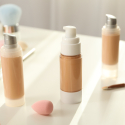Managing Frizzy Hair: Comprehensive Tips and Tricks
 Frizzy hair can be a persistent challenge, but with the right approach, it is manageable. Understanding the causes and implementing targeted solutions can transform unruly locks into smooth, beautiful hair. This guide offers practical advice and tips to help you conquer frizz.
Frizzy hair can be a persistent challenge, but with the right approach, it is manageable. Understanding the causes and implementing targeted solutions can transform unruly locks into smooth, beautiful hair. This guide offers practical advice and tips to help you conquer frizz.1. Understanding the Causes of Frizz
Frizz occurs when the hair's cuticle layer is raised, allowing moisture to pass through and swell the strands. Several factors can contribute to this phenomenon.
Humidity and Weather
Humidity is a primary culprit for frizz. When the air is humid, hair absorbs moisture, causing it to expand and become frizzy. Similarly, cold weather can strip hair of its natural oils, leading to dryness and frizz.
Hair Damage
Frequent use of heat styling tools, chemical treatments, and harsh hair products can damage the hair cuticle, making it more susceptible to frizz.
Hair Type and Genetics
Some hair types are naturally more prone to frizz. Curly and wavy hair, for example, are more likely to frizz due to their structure. Genetics also play a significant role in determining your hair's texture and propensity for frizz.
2. Essential Hair Care Tips for Frizz Control
Implementing a proper hair care routine is crucial for managing frizz. Here are some essential tips to keep your hair smooth and manageable.
Gentle Cleansing
Use a sulfate-free shampoo to gently cleanse your hair without stripping it of its natural oils. Avoid washing your hair too frequently, as this can lead to dryness and frizz.
Deep Conditioning
Regular deep conditioning treatments can help nourish and hydrate your hair, making it more resistant to frizz. Look for products containing ingredients like shea butter, argan oil, and keratin.
Proper Drying Techniques
After washing your hair, gently blot it with a microfiber towel or a soft cotton T-shirt to remove excess water. Avoid rubbing your hair vigorously, as this can cause frizz.
3. Effective Products for Frizz Control
Using the right hair products can make a significant difference in managing frizz. Here are some product recommendations to keep your hair smooth and shiny.
Leave-In Conditioners and Serums
Leave-in conditioners and serums can provide extra hydration and protect your hair from environmental damage. Apply these products to damp hair, focusing on the ends.
Anti-Frizz Sprays and Creams
Anti-frizz sprays and creams can help tame flyaways and smooth the hair cuticle. Use them on both damp and dry hair for best results.
Heat Protectants
If you use heat styling tools, always apply a heat protectant to shield your hair from damage. This will help prevent frizz caused by heat exposure.
4. Styling Techniques to Minimize Frizz
Styling your hair properly can also help reduce frizz. Here are some techniques to consider.
Air Drying
Whenever possible, allow your hair to air dry to minimize frizz. If you need to use a blow dryer, opt for a diffuser attachment and use a low heat setting.
Protective Hairstyles
Protective hairstyles, such as braids, buns, and twists, can help keep your hair smooth and reduce frizz. These styles also protect your hair from environmental factors.
Regular Trims
Getting regular trims can help prevent split ends, which can contribute to frizz. Aim to trim your hair every 6-8 weeks to keep it healthy.
5. Natural Remedies for Frizz Control
In addition to commercial products, natural remedies can also help manage frizz. Here are some home remedies to try.
Coconut Oil
Coconut oil is a natural emollient that can help moisturize and smooth your hair. Apply a small amount to your hair, focusing on the ends, and leave it on for a few hours or overnight before washing it out.
Aloe Vera
Aloe vera has hydrating properties that can help reduce frizz. Mix aloe vera gel with a few drops of essential oil and apply it to your hair as a leave-in treatment.
Apple Cider Vinegar
Apple cider vinegar can help balance your hair's pH level and smooth the cuticle. Dilute it with water and use it as a final rinse after shampooing and conditioning your hair.
Conclusion
Managing frizzy hair requires a combination of the right products, techniques, and routines. By understanding the causes of frizz and implementing these expert tips, you can achieve smoother, more manageable hair. With patience and consistency, frizz-free hair is within your reach.









